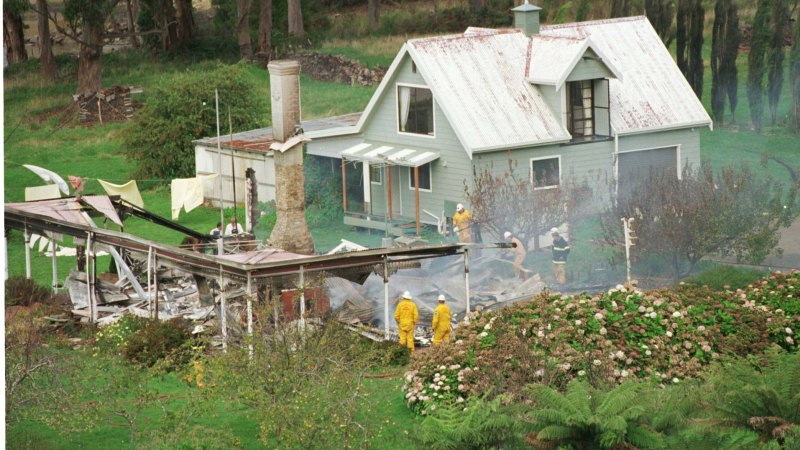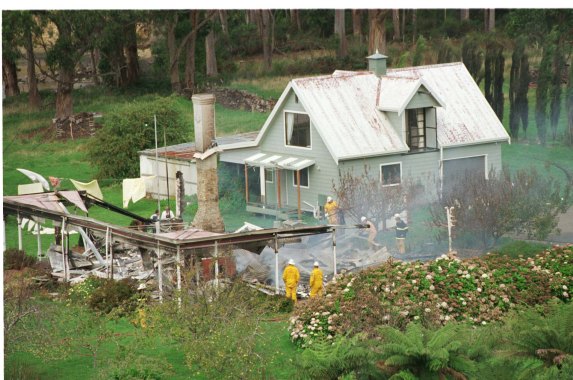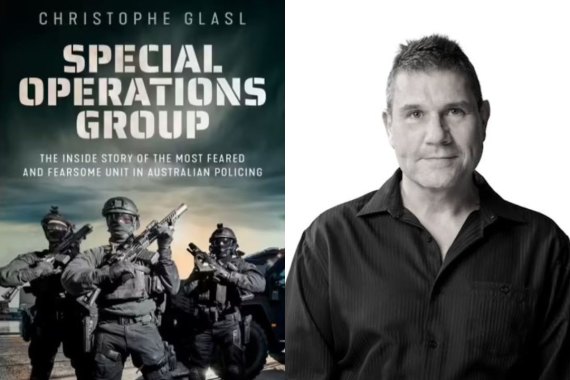Save articles for later
Add articles to your saved list and come back to them any time.
A former member of the Victoria Police special operations group has welcomed the withdrawal from publication of a memoir written by another former officer who falsely claimed he took part in the police operation at Port Arthur.
Hachette withdrew Christophe Glasl’s memoir Special Operations Group: The Inside Story of the Most Feared and Fearsome Unit in Australian Policing from sale on Monday after Victoria Police said it had “concerns about the accuracy of the book, including some of the author’s claims about jobs he attended”.
The Special Operations Group was sent to the Seascape guesthouse, seen here after the Port Arthur murderer was captured following a short siege.Credit: Jason South
Craig Harwood, a former team commander and sniper with the special operations group (SOG), posted a review on Amazon on Saturday in which he urged would-be readers not to buy the book. “It is not factual,” he wrote. Members of the SOG are understood to have contacted Hachette to raise concerns about the book.
In response to the withdrawal of the book, Harwood told this masthead: “The mission of having this fictional tale removed from public consumption and the unit’s integrity protected has been achieved and as such I wish to step back into the shadows or merge back into the foliage”.
In his prologue, Glasl explains he wrote the book to “blow the myth of the special operations group and to tell the story of what really happened within the confines of those walls. Drugs, lies, shooting, sex orgies, f-—ups on jobs, and the never-ending egos and testosterone of members believing they were better than anyone else … For certain legal reasons I will state that some of the stories may have been slightly embellished”.
Glasl claims to have been sent to Tasmania along with other members of SOG on April 28, 1996, the day of the Port Arthur massacre. He writes: “We rendezvoused at Essendon airport at the police air wing hangar; boarded a fixed-wing aircraft that was prepped and ready to go, and flew to Tasmania into the carnage”.
In chapter 18 he details the massacre and the tactics of Tasmanian police and the special operations group to capture Martin Bryant, who murdered 35 people that day. He writes about SOG’s Sniper One, codenamed Sierra, who was prepared to end the attempt to capture the assailant with one shot.
Narelle Fraser, who served in Victoria Police for 27 years, interviewed Glasl last year on her podcast where he repeated his claims about being present at Port Arthur. Glasl told Fraser that he arrived at Port Arthur in the evening and went to Seascape Cottages, where Bryant was holed up. During the interview he became upset when describing people who had tried to protect victims.
“I was affected emotionally by the heroic acts of these people that were actually in the Broad Arrow cafe at the time he started firing,” Glasl said.
Discussing the book, which at that stage was with Hachette editors, he said: “I didn’t write that chapter to put praise on the SOG because our job was quite easy when we got there. I wrote it to highlight these heroes. And that’s exactly what they were.”
In his review Harwood wrote that Glasl was not telling the truth. “He was never deployed to the Port Arthur incident and makes other operational claims about situations he was not present at or jobs he was never on,” Harwood said. Victoria Police confirmed to this masthead that Glasl was not present at Port Arthur.
The former sniper was also highly critical of Hachette. “The publishers did no fact checking,” he said. Victoria Police confirmed to this masthead they were not asked to fact check Glasl’s book.
The publisher has withdrawn Christophe Glasl’s memoir from sale.
In an interview with 3AW’s Neil Mitchell last year, Harwood said the role of the Alpha and Bravo SOG teams at Port Arthur was to “integrate, help contain and then resolve the issue”. They arrived at about 9pm. One of the reasons they had been called in was they had state-of-the-art day and night scopes for their guns and thermal imagery “that assist us at night”.
Harwood had changed his role from assault team commander to sniper. “I was Sierra One of the country and my team,” Harwood told Mitchell. In the book, Glasl calls the lead sniper Sierra.
Harwood said on 3AW, which is owned by Nine, the publisher of this masthead, that he thought the best resolution to the situation would have been a sniper shot. But the team was bound by use-of-force rules and had to be under direct threat. He pointed out that since the Lindt Cafe siege in 2014, these rules had changed.
“Despite [Bryant] firing [from the Seascape Cottages], there was no direct threat to any officer or anyone else for that matter of fact,” Harwood said. “We weren’t justified in taking the shot and believe me there was a lot of discussion afterwards about karma and the law and about what should have happened and could have happened but didn’t. We stay within the bounds of the law and what we’re able to do and what the circumstances presented. And there was never a clear shot on him.”
Christophe Glasl declined to comment for this story.
The Booklist is a weekly newsletter for book lovers from books editor Jason Steger. Get it delivered every Friday.
Most Viewed in Culture
From our partners
Source: Read Full Article


